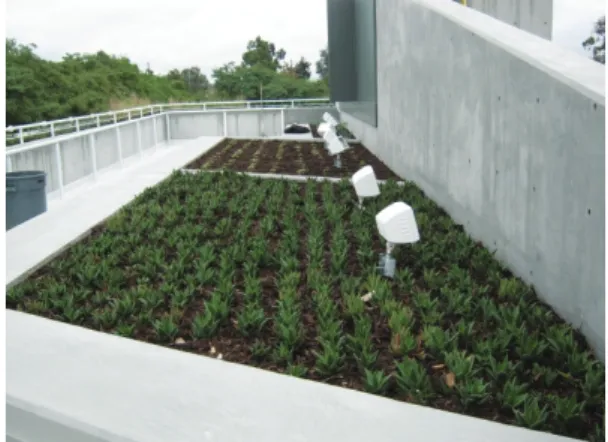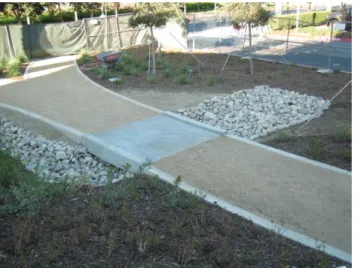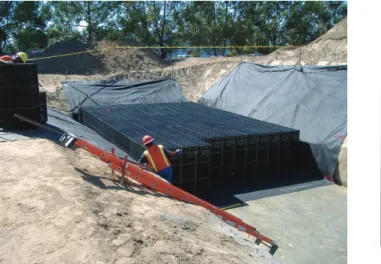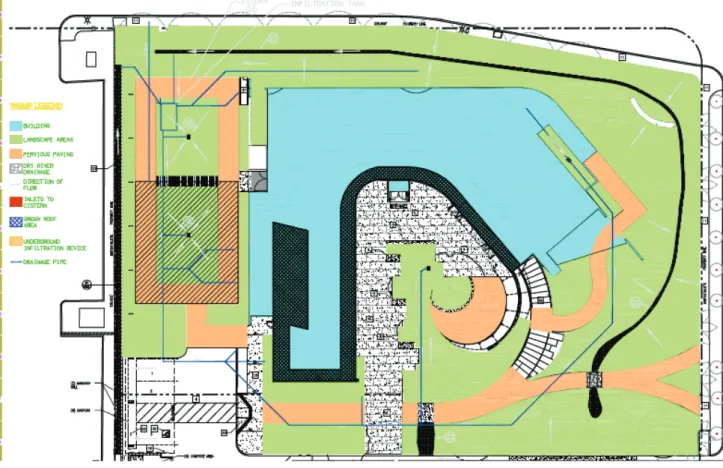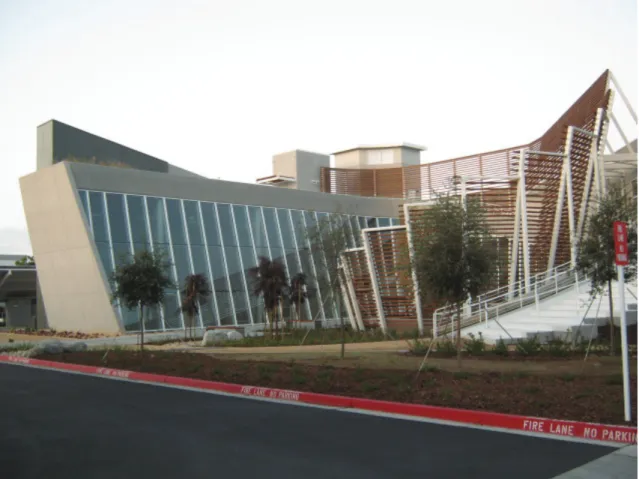Integrating Rainwater Harvesting and Low Impact
Development
Intégration des techniques de récupération des eaux
pluviales et de développement à faible impact (LID)
Daniel Apt
RBF Consulting, 14725 Alton Parkway, Irvine, CA, USA, 92618 (dapt@rbf.com)
RÉSUMÉ
Le district hydrographique de la Vallée de Cucamonga, en Basse-Californie, étudie la possibilité de construire un bâtiment à deux étages sur son campus. Le district a manifesté sa volonté d’intégrer des techniques de récupération des eaux pluviales et de développement à faible impact (Low Impact Development) au projet de construction pour se conformer aux normes de qualité de l’eau associées aux projets de nouveau développement ou de redéveloppement de moyenne et grande envergure. Un plan de gestion de la qualité de l’eau visant au respect de ces normes a été élaboré. La présente publication décrit le processus de planification de la qualité de l’eau ainsi que la méthode d’intégration des techniques de récupération des eaux pluviales et de LID sur le présent projet de redéveloppement. La capacité à réduire les polluants, le fonctionnement, les opérations de maintenance, les coûts et les avantages sont détaillés pour chacune des techniques sélectionnées pour ce projet. La présente publication dresse enfin un comparatif entre les systèmes traditionnels de traitement et les techniques de récupération des eaux pluviales et de développement à faible impact.
ABSTRACT
The Cucamonga Valley Water District in Southern California was interested in developing a new two story building on their campus that would incorporate rainwater harvesting and low impact development features to meet their water quality requirements. To meet compliance with stormwater quality regulations for new development or significant re-development projects of 5,000 square feet or more, water harvesting and Low Impact Development techniques were employed. The objective of development of the WQMP is to comply with water quality requirements associated with the significant re-development project. The paper explores the water quality planning process and how rainwater harvesting and Low Impact Development techniques were integrated to comply with the water quality requirements. Details of the water harvesting and LID measures selected for the project are presented including the pollutant removal capabilities, operation and maintenance measures, costs, the advantages of using the specific water harvesting and LID measures that were selected for the water district building, the way in which the measures were presented as beneficial to the project, and how the water harvesting and LID measures compare to traditional treatment controls considered for the project.
KEYWORDS
1 INTRODUCTION
The Cucamonga Valley Water District operates a campus in the City of Rancho Cucamonga. The project, known as the Frontier Project, consists of constructing a new two story building for the purpose of providing additional office space, meeting facilities and a public demonstration space to educate its customers and the public on environmental, especially water, sustainability. The project will be developed on an undeveloped portion of the campus of approximately 0.7 acres. The project will have an overall footprint of 14,411 square feet with the new building consisting of 9,547 square feet of that area. The project will include the building, landscaped areas, patios and walkways. The project qualifies as a priority project, under significant re-development projects with the addition or creation of 5,000 or more square feet on an already developed site requiring the development of a Water Quality Management Plan (WQMP) and implementation of structural Best Management Practices (BMPs) to meet compliance with County of San Bernardino and the City of Rancho Cucamonga water quality requirements. The Cucamonga Valley Water District and HMC Architects, the architect on the project, were pursuing a sustainable approach to development of the building that would include water harvesting and ground water recharge to help meet the District goals of stewardship of natural resources and recharging the local groundwater basins. The interest in water harvesting and sustainable approaches to stormwater management was expressed at the outset of developing the WQMP and so water harvesting and Low Impact Development (LID) were explored as sustainable approaches to meet water quality requirements.
Rainwater harvesting includes techniques used to capture and store stormwater runoff for future use. Often used in arid and semi-arid areas, water from these techniques is used for irrigation, providing water for animals, ground water recharge, and other domestic uses. In some areas of the world rainwater harvesting is the primary source of drinking water and water for domestic use. There are many different types of rainwater harvesting systems that can be configured to many different sites and land use types. Many of the rainwater harvesting systems are also identified as Low Impact Development techniques that exemplify using stormwater as a resource.
Low Impact Development (LID) is a different approach to conventional stormwater management that combines hydrologically functional site design and pollution prevention measures to offset the impacts of development on hydrology and water quality (PGC, 1999). The objective of an LID approach is to mimic the pre-development site hydrology by implementing site-design techniques that function similar to natural processes. By using LID techniques for development sites natural watershed hydrologic functions are maintained which results in fewer impacts to receiving waters from increased volumes and pollutants. LID techniques are also cost effective in many ways including their functionality as they can serve as landscape areas and so are multipurpose, they have lower capital and life time costs than conventional stormwater treatment controls, many of the LID techniques can be designed as part of a development’s open space (Lid-stormwater.net, 2007). LID incorporates site planning, hydrologic analysis, and integrated management practices into an overall stormwater approach. The integrated management practices identified in the LID approach were the primary focus in identification of “sustainable” approach to stormwater management and BMPs for the Frontier project.
LID Integrated Management Practices are distributed management techniques that assist in meeting the pre-development hydrologic regime and provide treatment for water quality. IMPs are designed for on site implementation, which integrates the site with the natural environment and eliminates the need for conventional end of pipe treatment controls that occupy large areas of land (PGC, 1999).
2 WQMP
METHODOLOGY
The methodology used to complete the WQMP for the Cucamonga Valley Water District Frontier Project in Rancho Cucamonga was based on the County of San Bernardino and the City of Rancho Cucamonga Water Quality Management Plan WQMP template. Within this template the information required includes project information, site and project descriptions, pollutants of concern and the hydrologic conditions of concern for the project, identification of BMPs, operation and maintenance, funding, and certification that the WQMP is in compliance with water quality requirements. The methodology in approaching the primary information is provided in the following sections.
2.1 Identification of Pollutants of Concern
The pollutants of concern for the Frontier project were identified by using Table 2-1 Pollutants of Concern for Project Categories and Land Uses in the San Bernardino County Stormwater Program Model Water Quality Management Plan Guidance (San Bernardino County, 2005). This table identifies expected or known pollutants identified with the priority project categories and the potential pollutants that may be associated with priority project categories depending on activities for a development site. The expected pollutants from the Frontier project include trash and debris, and oil and grease. The potential pollutants include bacteria/viruses, nutrients, pesticides, organic compounds, sediments, and oxygen demanding substances. The expected and potential pollutants for the Frontier project are based on those pollutants identified as expected and potential for the priority project category of significant re-development projects with the addition or creation of 5,000 or more square feet on an already developed site.
The WQMP template requires identification of the receiving water that the project discharges to for identification of downstream 303(d) listed impaired waters, Total Maximum Daily Loads (TMDLs) and potential hydrologic conditions of concern. The Frontier project site drains to a local street and is conveyed through other streets eventually discharging into Deer Creek Channel which outlets into Cucamonga Channel and then Mill Creek just prior to discharging to the Prado Basin which drains into Santa Ana River Reach 2, then Reach 1 which ultimately discharges to the Pacific Ocean. Cucamonga Channel has a TMDL for bacteria, Mill Creek is listed on the 303 (d) list for nutrients and has a TMDL for pathogens, and Prado Basin is listed on the 303 (d) list for nutrients and has a TMDL for pathogens. If the pollutants associated with the 303(d) listed receiving waters and the TMDLs downstream of the project are also identified as pollutants of concern for the project treatment controls must be implemented to address the pollutants of concern. Ultimately the pollutants of concern for the project included trash and debris, oil and grease, bacteria, and nutrients.
2.2 Identification of Hydrologic Conditions of Concern
New development and redevelopment projects may result in increased area of impervious surface on a development site. The result of this increase is a change in the hydrologic regime of a site including increased volume, flow durations, and peak flow. The change in the hydrologic regime may have the affect of eroding downstream channels, which has the potential to affect habitat and water quality. A change to the hydrologic regime of a site is considered a Hydrologic Condition of Concern (HCOC) if the change would have a significant adverse impact on downstream natural channels and habitat integrity, alone or in conjunction with impacts of other projects (San Bernardino County, 2005). The Frontier project without BMPs was identified as having a Hydrologic Condition of Concern as it does not discharge to an engineered channel with adequate flow capacity as it discharges to a local street. With the use of water harvesting and an underground infiltration device the Frontier project was found not to have a hydrologic condition of concern as the project runoff rates, volumes, velocities, and flow duration for the post-development condition will not exceed those of the pre-development condition for the 1-year, 2-year and 5-year frequency storm events.
2.3 BMP
Selection
The BMP selection process includes identifying BMPs to address the pollutants of concern and hydrologic conditions of concern. The BMPs are identified in three categories: site design, source control, and treatment controls. The objective of site design BMPs are to incorporate project features that help maintain the pre-development hydrologic regime. Source Control BMPs reduce the potential for pollutants to enter the stormwater system be restricting use of certain materials or through alternative pollution prevention operation and maintenance activities. Treatment controls are measures designed to remove pollutants from urban runoff and stormwater. Site design BMPs, source controls, and treatment controls were selected for the Frontier project to address the pollutants of concern. The site design and treatment control measures selected focused on Low Impact Development and water harvesting and are identified in the following sections. Implementation of BMPs ensures that the Frontier project effectively mitigates any watershed impacts.
2.4 Operations and Maintenance
The WQMP requires identification of operations and maintenance activities associated with the identified BMPs for the project. The operation and maintenance section of the WQMP requires identification of each BMP that requires operation and maintenance, a description of the activities, a schedule of activities, description of inspection and monitoring of BMPs, and identification of the responsible parties for performing and funding the operation and maintenance. The WQMP for the Frontier project identified the operations and maintenance components of the project by identifying the maintenance inspection protocol, inspection frequency, and maintenance activity required for each BMP, the inspection and maintenance records to be kept, and the responsible party for performing BMP operation and maintenance and keeping records of inspections and maintenance activities.
3 WATER HARVESTING AND LOW IMPACT DEVELOPMENT MEASURES
As part of the WQMP process once the pollutants of concern and hydrologic conditions of concern were identified water harvesting and LID measures were identified to help maintain the pre-development hydrology and to treat for the pollutants of concern. The way in which the water harvesting and LID measures were presented as beneficial to the project included a description of the measure and how the measure removes pollutants, the pollutant removal capabilities of the measure, operation and maintenance, costs, and the advantages of the measure in comparison to conventional practices. These components of each water harvesting and LID measure and the sizing of the LID integrated management practices is presented in the following sections.
3.1 Green
Roof
A green roof was selected as a site design LID measure in the Frontier project WQMP. Green roofs are multi-beneficial structural components that help to mitigate the effects of urbanization on water quality by filtering, absorbing, detaining and evapotranspirating rainfall. They are constructed of a lightweight soil media, underlain by a drainage layer, and a high quality impermeable membrane that protects the building structure. The soil is planted with a specialized mix of plants that can thrive in the harsh, dry, high temperature conditions on the roof and tolerate short periods of inundation from storm events. A photo of the Frontier Project green roof is provided in Figure 1 and a cross sectional diagram of a green roof is provided in Figure 2.
Figure 1 – Frontier Project Green Roof Figure 2 – Cross Sectional Diagram Green Roof Source: USEPA, 2008
Green roofs contribute to improved water quality by retaining and filtering the rainwater through the soil and root uptake zone, and through:
Vegetation, which slows down the water through friction and root absorption;
Evapotranspiration of rainfall.
Typical study results indicate that most of the heavy metals and other nutrients present in stormwater are bound in the soil substrate instead of discharged into streams or rivers. It is estimated that over 95% of cadmium, copper, lead and 16% of zinc can be taken out of rainwater by green roofs and that nitrogen levels can be reduced (London Ecology Unit, 1993).
3.2 Porous
Concrete
Porous concrete was selected as a site design measure for the Frontier Project to reduce the volume of runoff discharging from the site. Porous concrete provides a stable, functional surface like traditional paving systems, but also allow water to percolate through the material and infiltrate into the ground. This allows for reduction in impervious surface areas at a project site. If soils are not appropriate for infiltration under drains can be used. Porous concrete is composed of course aggregates, hydraulic cement and other cementitious materials, admixtures, and water. Porous concrete can be highly permeable, with permeability rates of approximately 200 inches per hour (Stormwater Management Academy, University of Central Florida, 2007). While clogging due to the presence of excessive sediment is possible, porous concrete can retain significant permeability after prolonged use if proper maintenance of the surface is performed. The recommended cross-section consists of a concrete layer, top filter layer, reservoir layer, bottom filter layer, filter fabric and underlying soil. The cross section of the porous concrete is provided in Figure 3 and a photo of the porous concrete implemented in the Frontier Project is provided in Figure 4.
Figure 3 – Cross Sectional Diagram Porous Concrete Figure 4 – Frontier Project Porous Concrete
3.3 Decomposed Granite Pervious Walkways
Decomposed granite was selected as a site design measure for walkways and paths in the Frontier project as an alternative to impervious pavement. Decomposed granite provides a stable, functional surface like traditional paving systems, but also allows water to percolate through the material and infiltrate into the ground. This allows for reduction in impervious surface areas at a project site. The decomposed granite is effective as it removes pollutants by infiltrating in the ground and helps to maintain the pre-development hydrology of the site. Decomposed granite can be assigned a runoff coefficient as low as 0.5 (Strom et. al., 1993) which helps to maintain the pre-development hydrologic conditions. The depth of a decomposed granite pathway should be approximately three inches and application should take place in stages, applying 1.5 inches soaking with water and allowing to sit for 8 hours and then compacting and repeat the process (Loosley, 1994). Downspouts should not be conveyed directly to decomposed granite walkways as erosion may occur. A common misconception is that decomposed granite requires no maintenance. Maintenance for decomposed granite includes raking to remove weeds or moss, and may need to be redressed with additional material periodically
and adjusting grades if necessary and inspecting surrounding vegetation and restabilization of vegetation if necessary. A photo of one of the decomposed granite walkways in the Frontier Project is provided in Figure 5 and a photo of decomposed granite material is provided in Figure 6.
Figure 5 – Frontier Project Decomposed Granite Walkway Figure 6 – Decomposed Granite Material
3.4 Rainwater Harvesting Cistern
A cistern was selected as a water harvesting and LID measure in the Frontier project WQMP. The reuse of stormwater onsite was a primary goal of the project to provide education for the Cucamonga Valley Water District customers. Cisterns capture and store stormwater that can be used later for irrigation or other domestic uses such as toilet flushing or clothes washing. Cisterns come in many varieties including above ground units and below ground units. The cistern that was selected as part of the Frontier project is the Xeres® Cistern. The irrigational needs of the Frontier complex were coordinated with the landscape architect and then the cistern was sized according to these needs, which were 1,600 gallons per day. The cistern for the Frontier project is not sized for water quality requirements but does have an overflow that discharges to the underground infiltration device which is sized for the water quality. Water is conveyed to the cistern from the roof of the building via a rain chain and into a capture structure. A photo of the Xeres® Cistern during installation at the Frontier Project is provided in Figure 7 and a photo of the rain chain that conveys water from the roof and the capture structure is provided in Figure 8.
3.5 Underground Infiltration Device
An underground infiltration device was selected as the primary treatment control for the Frontier project. The two primary reasons why this was selected as the primary treatment control were the desire by Cucamonga Valley Water District to maintain groundwater recharge on the site and a requirement, due the presence of a hydrologic condition of concern for the site, that the project runoff rates, volumes, velocities, and flow duration for the post-development condition will not exceed those of the pre-development condition for the 1-year, 2-year and 5-year frequency storm events. The delta between the volume of the post-developed condition and the pre-development condition for the 5-year frequency storm event will be retained on site through infiltration using an underground infiltration device. This volume was greater than the water quality volume and so the water quality and hydromodification requirements and the District’s goal of maintaining the groundwater recharge were obtained with the implementation of the underground infiltration device. The retention volume required was 6164 cubic feet which was based on the delta between the volume of the post-developed condition and the pre-development condition for the 5-year frequency storm event. The system designed is approximately 16 feet wide by 100 feet long by 4.5 feet high and has the capacity to infiltrate 7,200 cubic feet of water. The underground infiltration device that was selected as part of the Frontier project is the Atlantis® Infiltration Tank. The Atlantis® Infiltration Tank is constructed using lightweight cubical structural components made of recycled materials and can be constructed to hold any volume required being limited only by the area available. A photo of the Atlantis® Infiltration Tank during installation at the Frontier Project is provided in Figure 9 and photo of the Atlantis® Infiltration Tank cubical structural component that makes up the infiltration tank is provided in Figure 10.
Figure 9 – Frontier Project Atlantis® Infiltration Tank Figure 10 – Atlantis® Cubical Structural Framework
3.6 Water Harvesting and LID Measure Selection and Coordination
Early coordination in the site design process and presentation of the details and advantages of implementing the water harvesting and LID measures as part of this coordination resulted in the water harvesting and LID measures identified above being selected for the site. The advantages presented included reductions of impervious surfaces and subsequent volumes of runoff for the site design measures including the green roof, porous concrete, and the decomposed granite walkways. Other advantages presented included aesthetic benefits of the green roof, meeting irrigation needs with the cistern, recharging groundwater with the underground infiltration device and the educational benefits of all the LID measures implemented. Identifying these benefits to the Cucamonga Valley Water District and linking them to some of the District’s goals was critical to incorporating LID measures into the project. Incorporation of these measures into the Frontier project required early coordination with District staff to identify the Districts goals and identify the advantages of the rainwater harvesting and LID solutions to accomplish these goals. Coordination with the landscape architects also took place early in the design process for plant selection for the green roof and the use of decomposed granite for the walkways. Cucamonga Valley Water District’s interest in a “sustainable” approach to stormwater management and an interest in rainwater harvesting provided an opportunity to present
incorporation into the project because the advantages of implementing these measures were provided very early in the design process. The layout of the rainwater harvesting and LID measure for the Frontier project is provided in Figure 11.
Figure 11 – Frontier Project Layout
The Frontier Project Layout presented in Figure 11 identifies the locations of all of the LID measures incorporated into the project. The configuration of the LID features served to both meet the water quality requirements of the site but also provide an education opportunity for visitors to the building. This educational component also was a factor in the selection of many different LID features. A photo of the completed Frontier Project is provided in Figure 12.
Figure 12 – Completed Frontier Project
4 CONCLUSION
Development of the WQMP for the Cucamonga Valley Water District Frontier Project in Rancho Cucamonga, California has proven the following about water harvesting and Low Impact Development measures:
The advantages of water harvesting and LID measures must be presented early in the design process
Water harvesting and LID measures can be used simultaneously to meet water quality and hydromodification requirements
LID measures can also be effective in ground water recharge
Water harvesting and LID are cost effective stormwater management approaches that have effective pollutant removal capabilities
The water quality requirements of the project required retention of 6164 cubic feet of water on site to ensure there was not hydromodification impacts downstream of the project. Through the use of the LID measures the site will retain in excess of 7,200 cubic feet of water. Rainwater harvesting and Low Impact Development measures can be integrated for a project to effectively meet water quality goals and water quantity reduction goals. Theses measure should be discussed very early in the planning process so they can be effectively integrated into the design of the project. The architects, engineers, landscape architects, and the owner of the project meet early in the planning stages of the Frontier Project discuss the goals of the project. The Cucamonga Valley Water District as the owner identified that sustainability and water and sustainable education were the key goals for the project. Integrating rainwater harvesting and Low Impact Development were identified as the stormwater approach to meet the goals of the District. The results of using rainwater harvesting and LID as part of this project will be an aesthetically pleasing Cucamonga Valley Water District Frontier complex that is using a “sustainable” approach to stormwater management that will ensure improvement to the water quality of the runoff from the site, maintain ground water recharge, provide for the irrigation needs of the Frontier site, and provide an educational opportunity for Cucamonga Water District customers and visitors. The Frontier Project serves a model example of how integration of rainwater harvesting and Low Impact Development is a feasible sustainable approach to stormwater management.
LIST OF REFERENCES
Lid-stormwater.net (2007), Introduction to LID, http://lid-stormwater.net/background.htm#talkingpoints_LID London Ecology Unit, (1993) Johnson, Jacklyn and Newton, John. Building Green: A Guide to Using Plants on Roofs, Walls, and Pavements.
Loosley, Scott (1994), The One True Path
http://www.paloaltoonline.com/weekly/morgue/real_estate/1994_Jul_8.GARDQA08.html O’Connel, Michael, (2009), Turned Earth,
http://www.oclandscape.com/ocblog/2009/02/decomposed_granite_problems.html
Prince George’s County (1999), Low Impact Development Design Strategies An Integrated Design Approach, Department of Environmental Resources, Programs and Planning Division
San Bernardino Stormwater Program (2005). Model Water Quality Management Plan Guidance, June 2005. State of Maryland (2000), Maryland Stormwater Design Manual, Volumes I and II, October 2000
Stormwater Management Academy, University of Central Florida, (2007). Chopra, Wanielista, Spence, Ballock and Offenberg. Hydraulic Performance of Pervious Concrete Pavements
Strom, Steven and Kurt Nathan. Site Engineering for Landscape Architects. 1993. Table 8.1P. 106,
The Texas Manual on Rainwater Harvesting, Texas Water Development Board (2005), http://www.twdb.state.tx.us/publications/reports/RainwaterHarvestingManual_3rdedition.pdf
